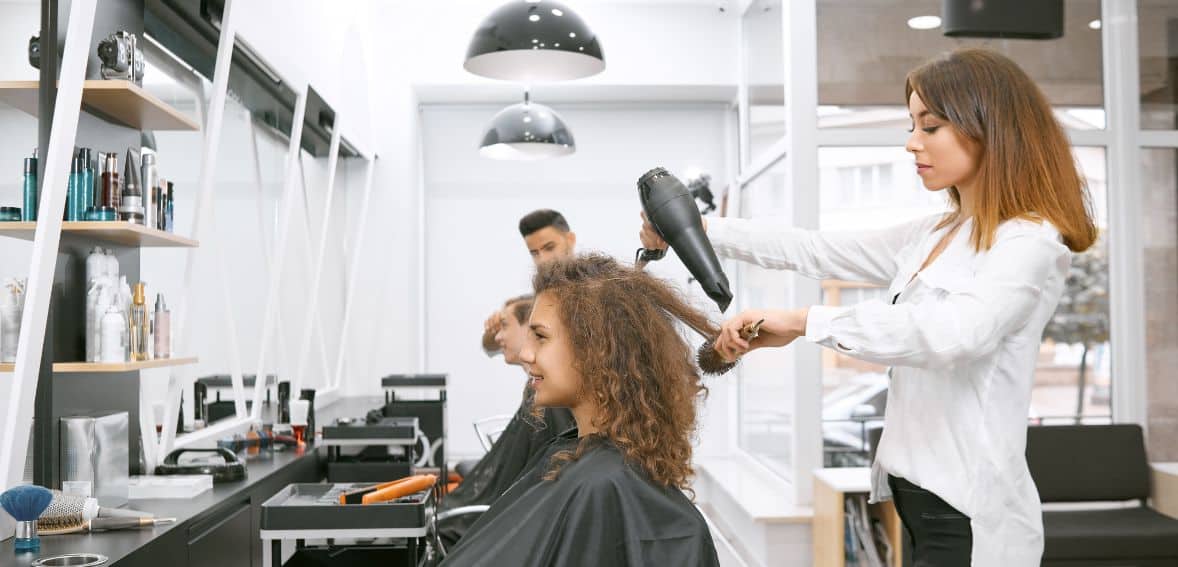
By Aiden King September 18, 2025
Chargebacks and fraud are an increasing issue in the beauty industry that impact profits and consumer confidence. From card theft to service disputes, these problems can heavily impact money and time. The good news is that beauty businesses and salons can lower risks through clear policies, secure payment methods, and being proactive with consumer communication.
The Rise of Fraud and Chargebacks in the Beauty Industry

Digital payment fraud is a serious threat to salons and beauty businesses. Without the right safeguards, fraudsters can use stolen payment information to make big purchases before anyone notices, especially if you sell through multiple channels like apps or websites.
Providing additional payment avenues for the customer can add to the risk. Thieves now prey on newer technology such as Apple Pay, buy now pay later (BNPL), contactless, and even cryptocurrency. These are just as risky as traditional credit or debit cards.
The largest concern is that your business typically bears the costs of these losses. If a stolen credit card is used to purchase goods or services on your website or mobile app, your merchant account loses the money. That’s why preventing digital payment fraud is so critical.
How Chargeback Fraud Can Harm Your Beauty Industry

Chargeback fraud can be devastating to a beauty industry, both financially and emotionally. The most direct impact is losing money, since you lose the payment for the service as well as the time invested in that appointment. To small beauty businesses with tight margins, even one or two chargebacks can make a huge impact.
It is also stressful and time-consuming to fight a chargeback. You must take evidence of the transaction’s reality and present it to your bank, which is complicated. This one turn affects your attention to other customers and appointments, and you lose even more revenue in the long run.
In addition to that, frequent chargebacks will become increasingly difficult to deal with payment providers such as Visa or Mastercard. They will consider your beauty business as a high-risk enterprise, and future approval for merchant accounts will be more challenging. In general, chargeback fraud doesn’t only cost money—it impacts your time, effort, and capacity to keep your business running smoothly.
Popular Marketing Strategies and Their Impact

Social media influencers play a massive role in making a product go viral. When a social media influencer discusses a beauty product, people pay attention and buy it. Sites such as TikTok are particularly potent—many have bought products simply because they saw them trending. Team up with influencers to get your products seen by a larger audience in a short time.
But do you know there are some risks associated with working with influencers? Giving promo codes or affiliate links can sometimes be misused. Customers might have multiple accounts in order to use a one-time code, or might attempt to make illegitimate claims for commissions they don’t actually earn. This can damage your bottom line and waste marketing budgets.
To prevent promo code and affiliate abuse, carefully plan campaigns, track influencer behavior, inform partners about proper usage, and establish limits on code use or expiration dates. These actions maintain your marketing efforts effectively while minimizing fraud. Resellers and distributors can also assist in getting your goods into the hands of users globally. But resale fraud is a genuine threat. Stolen, fake, or damaged items may be sold by some resellers.
As soon as products are out of your hands, you lose much control over who receives them and how they are sold. Your brand and reputation can suffer as a result. To avoid this, track your products with serial numbers, collaborate with marketplaces to delete imitation listings, and screen high-dollar transactions and distributors thoroughly.
Subscription products are another excellent method of producing a consistent income. People who frequently use products such as face creams or serums are able to subscribe to regular deliveries, which equates to loyalty and consistent revenue. But just like the above it also contributes to some drawbacks: subscription programs are susceptible to friendly fraud.
Consumers may inadvertently or even purposefully contest an authorized purchase as a chargeback. This may occur when a subscription box is lost, delayed, or damaged. To avoid this, inform customers clearly regarding subscription dates and fees, simplify cancellation, and send notifications prior to payment processing.
Customer reviews are essential to drive sales. Positive reviews increase trust and induce new customers. But reviews can be faked. Some scammers use threats of negative reviews in exchange for free products or refunds. Such return or refund fraud can strike your bottom line hard.
To combat refund fraud, have well-defined policies with deadlines or usage stipulations, request evidence such as photos of defective products, and monitor trends through account, device, and purchase history data.
Tight policies and monitoring prevent revenue losses while still making genuine customers happy. By integrating vigilant planning, observation, and open communication, you can expand your beauty business while avoiding risks from influencer promo abuse, resale fraud, subscription disputes, and refund scams.
Why Chargebacks Occur

Chargebacks may occur for numerous different reasons, and it is crucial to know them so that you can safeguard your business. At times, clients don’t notice the charge on their bank statement because it appears under a different name, such as “Stripe, CA,” or the tip will be seen as a separate transaction. Clients also dispute charges for failed appointments or late cancellations, although this is a typical policy.
The best protection for yourself is saving messages, emails, or signed intake forms that clearly indicate your policy. Some clients actually go to their bank if they are dissatisfied with the service or cost without coming to talk to you first.
Negotiating prices ahead of time, agreeing on add-ons, and ensuring they’re happy before departing can assist in fixing things before they become a major problem. Banks will also have several charges if a client complains about something other than their service, so requesting the client to check with their bank will resolve this issue. Errors such as not stamping “paid in cash” can also result in double charges, so double-check at checkout.
Sadly, there are also scam clients who pay with stolen cards, and in such instances, the legitimate cardholder will file a chargeback. Stopping fraudsters and reporting them is the ultimate protection. Although chargebacks are frustrating, maintaining good records and being transparent with clients provides you with the best protection.
Chargeback Prevention Strategies for Your Business

1. Be Clear About Your Services
Ensure your clients understand precisely what they’re paying for. Elaborate distinctly what each service entails, your rescheduling policy, and how membership or the package operates. Having seen the “Policies” link on your site is far more effective than hiding terms towards the bottom of a page. Being transparent avoids misunderstandings that would result in chargebacks.
2. Implement Secure Payment Systems
Your payment processor can help you defend against disputes. Keeping accurate records of transactions, including dates, times, and payment methods, can make it much easier to prove a legitimate sale if a chargeback occurs. It also helps if you track any previous suspicious activity from a client.
3. Keep Thorough Records
Documentation is your best ally when there’s a chargeback. Save client profiles, appointment schedules, and communication history. Having all this organized in one place, preferably in your management software, can assist you in responding promptly and demonstrating that you delivered your service.
4. Have Clear Refund Policies
A straightforward and equitable refund policy can avoid misunderstandings. Ensure customers view your policy prior to scheduling so they know when refunds are possible and when they are not. This can avoid arguments before they arise.
5. Red Flags
Others attempt credit card fraud by stealing or manufacturing fake cards. Be careful with new customers—verify identification and compare it with the card they are presenting. Identifying suspicious transactions up front can avoid major chargeback problems.
6. Prevent Friendly Fraud
Occasionally, clients unintentionally initiate chargebacks for valid transactions. This may occur when your business name appears unknowingly on a statement or when another person utilizes the card without authorization. Prevent this by prominently displaying your business name on statements and confirming IDs when appropriate.
Even with precautions, chargebacks can still happen. Make a plan for responding politely and professionally. Gather your records, show your policies, and present proof that the service was provided. Staying organized and professional increases your chances of resolving disputes in your favor.
Merchant Chargeback Rights
When a client disputes the charge, it’s stressful to your business, but keep in mind, you have rights as a merchant. Knowing them can assist you in protecting your income and fighting back.
When a chargeback occurs, the payment is held in your account temporarily for the client, but this doesn’t necessarily mean the client gets to win the dispute. You may fight the chargeback by using a process referred to as representation.
This provides you with the ability to present evidence such as signed papers, receipts, and return or service policies to demonstrate that the transaction was valid. Well-defined policies and accurate documentation simplify it considerably to defend your case.
Second, you are entitled to understand why the chargeback occurred. The client is required to give their bank a reason, which is then communicated to you as a reason code. These merchant codes inform you precisely why the client is fighting the charge, e.g., fraud or unauthorized use. Knowing the reason code informs you what proof to send to contest the chargeback.
You also have the right to receive your products back. In case a client reports a product was defective, you can request it be returned prior to the chargeback going through. This even works for products which were already sent out to customers. Requiring clients to try a return first can avoid unnecessary chargebacks.
Another significant right is that you only have to refund the price they paid. You will not be asked to pay more than what the client initially paid. If they have already had a part of their money returned, received a discount, or cashback, the chargeback only works for the money left paid for the good or service. Chargeback fees from your bank are different, but at least you’re not paying more than you have to.
Lastly, you are entitled to a statute of limitations. Clients have the ability to file chargebacks within a set amount of time, depending on the reason code. Some must take action within a few weeks, while others provide up to 120 days. After the time has expired, the transaction is covered, allowing you to rest easy.
You can’t stop every chargeback from happening, but understanding your rights provides you with the resources you need to respond assertively, defend your business, and minimize financial losses.
Chargeback Rebuttal Letter
MID: 1122334455 | Business Name: LuxeGlow Salon
Dispute ID: 77889901
Hello,
LuxeGlow Salon offers professional hair, beauty, and spa services from our location at 451 Main Street, Dallas, TX. On July 15, 2023, customer Sarah Miller booked a full hair coloring and styling package. Miller’s Mastercard ending in 3344 was charged $225.00 at the time of service.
On the appointment date, Miller received the complete service, including consultation, coloring, cut, and blow-dry. She signed our service completion form before leaving the salon, confirming she was satisfied with the results. We also provided an itemized receipt via email the same day.
Despite this, Miller filed a chargeback on August 2, 2023, claiming the service was not delivered. We are disputing this claim with the following evidence:
- Signed Service Record: Proof that Miller received and approved the completed service.
- Receipt and Policy: A copy of the emailed receipt, which includes our policy on adjustments and corrections.
- Appointment Confirmation: The original booking record from our scheduling system showing the service was performed as scheduled.
Our salon has a clear satisfaction policy in place and always encourages clients to return if adjustments are needed. In this case, the customer did not reach out before filing a dispute. The attached documentation shows that services were fully delivered. For these reasons, we request the chargeback be reversed.
Sincerely,
Billing & Client Relations
LuxeGlow Salon
Conclusion
Fraud and chargebacks are part of running a beauty business, but they don’t have to blow you away. You can secure your revenue while keeping customers satisfied through open policies, secure payment systems, and effective customer communication. Being smart and ahead of the game is how you mitigate risk and establish long-term trust in your brand.
FAQs
Why is the beauty industry a target for fraud?
Beauty products are inexpensive, compact, and easy to resell, which makes them highly suitable for fraud testing and rapid profits.
What is friendly fraud in beauty sales?
It occurs when a genuine customer contests a valid purchase, usually because of buyer’s remorse or neglect of a subscription.
How can salons minimize chargebacks?
Clarity of policies, documentation of services, and advanced communication regarding pricing or cancellations ensure fewer disputes.
Are used beauty products returnable?
Most beauty products can’t be returned if they’ve been opened, so it may lead to disputes—clear return policies can save businesses.
What mechanisms prevent fraud in beauty retail?
Fraud detection software, transaction monitoring, and using secure payment providers can prevent most fraudulent attempts.